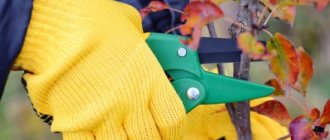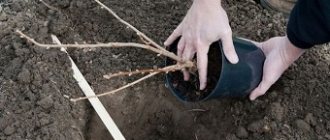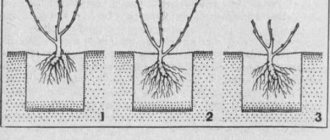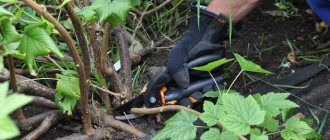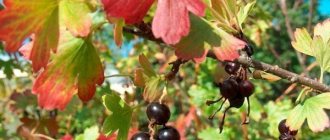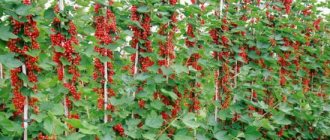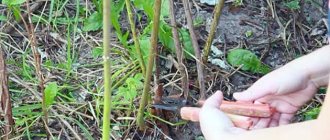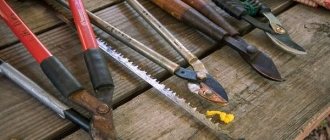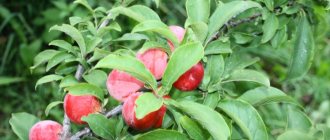In autumn, when all the harvest has been harvested and all the preparations have been made, it is time for calm. During this period, gardeners have free time to properly engage in autumn processing of plants. In this article we will talk about when and how to plant currants in open ground so that they take root well and produce an excellent harvest in the spring.
There is absolutely no difference in what variety you plant - red, white or black. Planting currants in the fall is carried out according to the classical scheme.
Pros and cons of autumn planting currants
Of course, autumn work is always a risk. But they have a number of advantages over spring planting:
- Rooting occurs in a shorter time.
- Pest activity is minimal.
- The plant adapts faster.
- In spring, seedlings appear almost simultaneously.
- The crown is formed more actively.
If the autumn planting of currants is carried out correctly, the bushes will not only take root well, but will also produce an excellent harvest in the summer.
In this work, even the slightest recommendations cannot be neglected; every detail is important both during planting and during the period of care after its completion.
The key to success is the right location on the site. The main thing is reliable shelter from draft winds. Protection can be either neighboring plantings, or a fence or walls of buildings.
Another danger of autumn is early frosts. You can’t completely rely on weather forecasters, so it often happens that cold weather hits before the roots have time to get stronger. To avoid the death of seedlings, they must be additionally covered at night.
Currant planting dates
There is no specific time for planting currants. It is different for each region. In addition, even in a familiar climate, atypical weather conditions may occur. All these factors can shift the recommended work schedule.
Experienced gardeners know that the longer it stays warm, the later you can start planting currants.
The optimal period from planting to the first night frost is 3-4 weeks. During this time, the bush has time to adapt to the new place, and the roots become sufficiently strong.
But planting too early is also fraught with consequences: if the weather is good, then young shoots may begin to grow on the currants. In winter this is completely undesirable. In addition, an indicator of the readiness of a seedling for planting is the falling of leaves. If you plant a bush early, when the leaves have not yet had time to fall, then the liquid that the roots need so much will evaporate from their surface.
Important! If you missed the required deadlines and frosts are predicted earlier than expected, then it is better to postpone planting until spring. The finished seedling can be put into the basement until the snow melts.
By region
In any region, you can carry out both autumn and spring planting of currants.
| Region | Landing time |
| Northern regions, Ural, Siberia | Second half of August |
| Leningrad region | Early October |
| Middle lane, incl. Moscow region, Volga region | Second half of September – early October |
| Southern regions | Mid October |
These dates are approximate; you should still focus on the weather. The correct time to start work allows young currants to better adapt to the upcoming winter, and the parent bush to more easily survive the cutting process.
Many gardeners believe that the most suitable month is September, for some regions - its beginning, for others - the second half and end.
A young plant takes root in about 2-3 weeks; for white and red berries, this period can last up to four weeks. That is why frosts should not occur earlier than this period.
In the spring, you can start planting bushes after the snow cover has melted. This usually occurs at the end of March. By this time, the soil has already warmed up, and night frosts are practically excluded. The plantings do not need watering at first, the shoots begin to grow very quickly, the root system has time to adapt and take root.
Some novice gardeners delay planting seedlings; this can lead to the fact that there may not be any berries in the current season.
According to the Lunar calendar 2020
For many decades, the lunar calendar has been helping gardeners navigate the timing of planting garden crops. There are also favorable and unfavorable days for currants.
| Month | Favorable days | Unfavorable days |
| September | From 19 to 26 | From 1 to 2, 17, from 27 to 28 |
| October | From 3 to 13, from 18 to 21 | 2, 16, from 24 to 26, 31 |
| November | No | 15, from 20 to 22, 30 |
It is advisable to time the start of work so that it falls on suitable dates. Of course, this can be a big problem for those who come to the site only on weekends. But it is strictly not recommended to plant raspberries on unfavorable days, especially if the Moon is in the constellation Aquarius.
How to plant currants correctly in the fall: step-by-step instructions
Planting currants occurs in several stages. It all starts with choosing the optimal variety and preparing seedlings. Next, you need to decide on a place on the site, prepare planting holes, place currants in them and prune. We will dwell on each of them in more detail.
Selection of seedlings
High-quality seedlings are the key to an excellent harvest. It is important not only to choose them correctly, but also to prepare them for planting. There are several options for obtaining seedlings:
- take cuttings from an old healthy bush;
- buy planting material from a special nursery;
- grow a seedling from a grafted currant bush.
Very often, cuttings are taken from a favorite and proven variety, which has been growing on the site for a long time, but due to old age has begun to bear less fruit. It's time to update.
It is better to buy currants from reliable nurseries, this reduces the risk of running into diseased plants. When choosing planting material, you need to pay attention to the following points:
- the root system should be a bunch of healthy shoots, among which there are from 3 to 5 lignified skeletal roots with a length of 18 to 20 cm, and the fibrous system is well developed;
- there are from 2 to 3 healthy above-ground shoots, the height of which is approximately 30-40 cm;
- there are living buds on the stem;
- there are no visible damages or signs of diseases or pests on the bush;
When choosing a variety, you need to focus not only on its yield and taste of the berries, but also on whether it is suitable specifically for your region.
Many experienced gardeners graft a cutting from another variety onto a bush. In September, a shoot separates from it, which will subsequently become an independent bush.
If the seedlings have already been purchased, and their planting is postponed indefinitely due to various reasons, they should be stored by wrapping the roots with a wet cloth, which is covered with a layer of plastic film on top. This measure will prevent the root system from drying out.
How to prepare a seedling
The finished seedling will be stored only if the roots are covered with a damp cloth and placed in a bag.
Before planting a seedling in the ground, its roots are dipped into a clay solution, which is diluted to the consistency of sour cream. A two-minute soaking in any stimulant (Kornevin, Heteroauxin, etc.) will help activate root growth.
Advice! Before planting, roots that are too long are cut to 20 cm, dry areas are removed down to living tissue. All damaged shoots must also be removed.
Selecting a location
Each garden has its own type of soil, so it is important to choose the most suitable place for currants, taking into account the following parameters: chemical composition, moisture level, acidity, predecessors and neighbors.
Currants grow best on chernozem, loamy or fertile soil with low or neutral acidity.
The area should be well lit. A little shade from trees or building walls is allowed, but it should not prevent sunlight from reaching the bush all day. Otherwise, the branches will stretch in length, few buds will be formed, and accordingly, you can’t count on a good harvest.
Attention! Currants do not tolerate drafts and do not tolerate cold winds well, so the garden bed must be protected from them.
The shrub loves well-moistened soil, but does not tolerate stagnant water. If the area is swampy, the stems will become covered with lichens, which slows down the growth of the plantings.
Bushes can be safely planted in places where perennial herbs or vegetables were previously located. Beds after raspberries, gooseberries and other currants are absolutely not suitable.
In addition, close proximity to sea buckthorn, raspberry, gooseberry, walnut, pine or cherry is considered an unfavorable neighborhood.
Required materials and tools
To carry out gardening work, you will need a shovel, a watering can (or bucket), gloves, pruning shears, ash and other fertilizers (organic or mineral).
At what depth to plant
When preparing a hole, you need to focus on a size of 50 cm on all sides (length, width, depth). If necessary, you can increase this figure by 10 cm. In fertile soil, a hole 40 cm deep will be sufficient.
Advice! If you use a special container to plant currants, then it is enough to dig a hole 2-3 times larger than its size.
At what distance to plant
Even with a modest plot size, it is not recommended to reduce the distance between bushes. If the currants are too close to a neighbor, the plantings will thicken. This is fraught with disruption of aeration, which leads to the activation of diseases and pests.
A seemingly small bush will certainly grow and will need more free space.
The most suitable distance between currant bushes is considered to be 2 m; if urgently necessary, it can be reduced to 1.5 m. The same indicator must be observed between rows.
Important! When planting bushes near a fence or near the walls of a house, you need to step back at least 1 meter from them.
Well preparation
The minimum dimensions of the hole are 40 by 40 cm. In poor soils, these figures increase to 60 cm due to the need to place a bulk layer of fertilizer inside. The remaining soil after digging is used to prepare a nutrient mixture. If there is no need for this, then it is simply sifted, weed roots and large lumps are removed, then mixed with humus in a 2:1 ratio and the hole is filled up. A small remainder of the soil mixture is allowed, which is added as the soil subsides.
The optimal distance from one hole to another is from 1.5 to 2 m; the row spacing is allowed to be at least 1.2 m wide.
Fertilizer application
The amount of fertilizer applied depends on the quality of the soil on the site. If it is fertile, black soil, then a minimum of fertilizing is required. But more often than not, average Russian gardens cannot boast of high nutritional value of the soil.
Therefore, most often the beds need to be fertilized regularly. With their constant use, plants suck all vital microelements from the soil, causing it to become poor and useless.
Organic matter is ideal for sandy and clayey areas - 10 kg of compost or humus is added per square meter. Dolomite flour will help reduce acidity.
Dolomite flour
It is better not to apply mineral fertilizers in the autumn. They are most often effective at the plant growth stage. But organic matter will help prepare the plantings for winter. You can scatter humus over the surface of the bed, and then dig it about 25 cm deep. Such preparation will be most effective.
It is safe to add lime to the plants themselves only a year before planting them. An aggressive drug can burn tender roots.
Step-by-step landing instructions
We offer you a step-by-step guide to planting currants in the fall:
- Dig a hole and fill it about halfway with the nutrient mixture.
- If the soil on your site is dry and sandy, then water it before planting. Many gardeners water after the bush is planted. Focus on the specific features of your garden.
- Form a small cone-shaped mound in the center of the hole. It is only needed when planting a bush with an open root system. When the currants are placed in the garden directly in the container, there is no need to prepare any mounds.
- Place the bush at an angle of 45 degrees in the hole, then carefully straighten the roots. They should be positioned downward. Make sure that the roots do not bend or stick up.
Note! Unlike gooseberries, the currant bush is planted strictly at an angle of 45 degrees, while the shoot itself should be oriented to the north, and the roots to the south.
- Carefully fill the hole with the remaining soil, which you have previously mixed with peat or humus. Gradually lift the bush and shake it slightly so that the soil fills the interroot space.
- Compact the soil in the hole so that the seedling sits in it firmly enough.
Note! For each type of soil there is an optimal depth of the root collar. In heavy soil it is enough to deepen the plant only 5 cm, and in light soil - 10 cm due to its rapid subsidence. This will help the currants quickly sprout new shoots in the spring, which will increase the width of the bush and have a beneficial effect on the amount of harvest. By the way! The root collar is the place on the trunk from which the first root emerges.
- Form a small (5-10 cm in height) belt of soil around the bush.
- Water the soil inside the improvised belt. Such a restriction from the earthen embankment is necessary so that the moisture does not spread throughout the entire bed, but lingers near the planted currants.
- After the water is absorbed, water again.
Important! It is necessary to moisten the bed only if the weather has been dry and there has been no rain for a long time. If you feel that the soil is already wet, then water only as needed.
How to choose the right landing site
Currants prefer well-lit areas located on a gentle slope or small hill. Some varieties tolerate darkening well, so the shrub can be placed under the crown of a large tree. Currants can be planted next to a fence or other structure, but the distance from it should be at least 1 m. When planting next to other large plants, it is advisable to maintain an interval of 2 m in order to create optimal conditions for the development of roots, as well as for the convenience of subsequent construction of supports for the bush.
It is undesirable to plant currants in close proximity to any type of body of water, which leads to constant wetting of the roots and their rotting.
Good soil
All types of currants are recommended to be planted in areas where the soil has a slightly acidic or neutral acidity level.
If the substrate is acidic, then during planting 100-150 grams should be added to the planting hole. ground limestone or chalk. Fertile black soil is best suited for this crop, but loamy areas can also be chosen. The soil must retain moisture and have good aeration to avoid root diseases. Read about the Pinot Noir grape variety here.
What can't you sit next to?
It is not recommended to plant currants in the place where gooseberries or other types of currants previously grew. They release a toxin that is dangerous to the crop into the soil, reducing yield and growth rates. It is undesirable to plant shrubs in an area where moss or horsetail grows, which are a signal of increased soil acidity.
If you are planning to create a fruit and berry zone on your plot, then you need to carefully select crops. It should be remembered that black and red currants do not get along well with each other, and also react poorly to proximity with sea buckthorn, cherries, raspberries and blackberries.
You should not plant currant bushes next to Jerusalem artichoke or horseradish, which tend to grow very quickly, occupying the entire free area of the site.
What can you plant with?
There are a large number of cultivated plants that have a positive effect on the growth and yield of currants. Honeysuckle and homemade hops are considered the best neighbors in the area. You can also place a plum in close proximity to currants. And onions and garlic, planted nearby, can reduce the likelihood of infection by certain harmful insects, such as bud mites or spider mites. Read about the Chinese Snake cucumber variety here.
Methods for planting currants
Gardeners use three main methods of planting currants:
- Fan.
- Trellis.
- Classical.
Fan method
Not the usual holes are prepared for the seedlings, but a whole trench. The optimal width is 40 cm, and the length depends only on your wishes and the size of the area. The bushes are placed in it at a distance of 1 meter from each other, and the shoots are straightened along a pre-set low trellis in the shape of a fan. This method of planting gives plants more opportunities for development; usually the bushes in such trenches are almost twice the size of their relatives planted using the classical method.
The yield of currants is much higher than usual, but the fan-shaped method of cultivation requires additional efforts from gardeners to tie them up.
Vertical planting on a trellis
Vertical planting of currants on a trellis differs from the previous method in the way of creating a trench. It is enough to dig it 20 cm deep and 15 cm wide. Then the trench is filled with fertilizer, to which 50 g of nitroammophoska per 1 sq.m. is added. The remaining space is covered with earth. The bed is covered with a thick film, in which x-shaped cuts are made every 30 cm. Annual cuttings or seedlings will be planted in them to a depth of approximately 7 cm.
Classic way
The use of this method is recommended when there is a limited amount of planting material and in conditions where creating a trellis is not possible.
The wells are prepared using the previously described method and, if necessary, filled with nutrient substrate. One currant bush is placed in each at an angle of 45 degrees. To get as many shoots as possible in the spring, you can deepen it into the ground by 2-3 buds. In addition, the amount of harvest from such planting will increase over the next three years.
Planting red and white currants
It is preferable to plant black currant bushes to a depth of 10 cm; for red and white, 6-8 cm is sufficient.
Features of planting different types
Depending on the type of currant, there are certain planting nuances. They should be taken into account in order to obtain a high-quality and abundant harvest.
Black and golden currants
Black and golden currants grow well only on fertile, loose and moist soils. It does not tolerate wet or dry places.
Groundwater should be no closer than 70 cm to the surface of the earth. If the soil is acidic, then dolomite flour or lime is added to it. Otherwise, the plants will develop poorly and often get sick.
Important! Blackcurrant bushes are optimally planted to a depth of 10 cm.
Black currants require sufficient sun . Shaded places depress the plant, cause leaves to fall and reduce yield. The berries gradually become sour and small.
In the southern regions, the crop is planted in lowlands, as moisture is better retained there. But it is necessary that it does not accumulate there. These are moisture-loving plants, but they do not tolerate stagnant water .
Golden currants can be planted in shaded areas. It grows poorly on almost all soils except clayey ones.
White and red currants
White and red currants do not have the same requirements as black currants. To plant, it is enough to deepen the seedlings by 6-8 cm.
Features of choosing a planting site for colored currants:
- It can be planted on dry and not very fertile soils.
- White and red currants do not tolerate acidic and waterlogged soils.
- Requires good lighting.
- It is preferable to plant on slightly alkaline soils.
How to plant currants from a bush (propagate)
There are three main vegetative methods of propagation of currants, which we will discuss further.
By layering
Layers begin to be prepared in the spring. To do this, choose a healthy two-year-old branch that grows close to the ground. It needs to be deepened into the bed by 10-15 cm, having fertilized this place in advance. A part of the branch up to 30 cm long should remain on the surface of the ground. To keep it firmly in the ground, it can be attached using a special bracket or hook made of thick wire. All summer long this shoot will have to be watered and fed if necessary. With proper care, up to 4 new shoots will appear at the end of September, and the root system will have time to develop well. You can start replanting.
Green or woody cuttings
Cuttings are carried out by dividing one young healthy shoot into several small parts. To do this, you will need sharp pruning shears, which must first be disinfected so as not to introduce bacteria. The optimal length of the cutting is 20 cm, the upper cut is made straight, and the lower one must be oblique. This measure, firstly, will not allow you to confuse where is the top and where is the bottom. Secondly, with oblique pruning, a large surface area is provided, which greatly increases the likelihood of normal survival of the cutting. This work is carried out in mid-September (the exact timing depends on weather conditions). The cuttings are placed in a container with water overnight, and the next day you can begin planting them in pre-prepared holes.
By division
Currant division is carried out in the autumn. A healthy bush with a large number of shoots and a powerful root system is cut into 2-3 parts with a sharp tool. The cut areas are sprinkled with ash to avoid the development of infections. The separated part of the bush can be immediately transferred to the prepared permanent bed. The harvest can be harvested within a year.
Selection of seedlings and cuttings
Choosing the right seedling is the key to growing a healthy, fertile bush. In this case, you should not listen to sellers who advertise their product as the best; you need to inspect the bush yourself most carefully.
Important! To choose the right type of crop you want to purchase ( it can be black, white or red currant), lightly rub the shoot
-
if you smell a characteristic currant smell, it means it is a black variety. Red and white currants do not emit aroma. The first thing you need to pay attention to is the root system, by which you can determine whether the shrub is healthy or not. Ask the seller to make a small cut - if there is a white-green “body” under it, then everything is in order, but if it is gray or brown, feel free to refuse the purchase.
Buy one- and two-year-old seedlings, but you should not take older ones. The bushes should have good growth from last year in the form of light shoots with live upper buds. If you notice that the growth is depleted and its ends are dried out, there is a high probability that the seedling is affected by powdery mildew. It's not worth buying.
Also be careful about buying plants with deformed stem ends - this sign may indicate aphid infestation. The presence of another harmful insect - the kidney mite - can be determined by the overly large size of the kidneys. If you noticed this after the purchase, before carrying out planting work, treat the plants with insecticides (Confidor Maxi and Aktara help well).
Did you know? In addition to the fact that currants can be black, red and white, there are other varieties, for example, yellow, purple, orange. In America, there is a variety whose berries have black skin, but the pulp resembles white pulp and is very sweet.
Experienced gardeners advise “trimming” the bushes before planting so that about 6-7 buds remain on each stem - everything else needs to be trimmed. This procedure will help avoid early aging of the bush. If this is not done, the foliage that appears in the spring will begin to “pull” sap from the long stems. And since the root system cannot yet work at full strength to supply the necessary substances, the branches will begin to quickly age and become bare.
In the fall, you can start propagating currants by cuttings, and it is equally important to collect suitable material. To do this, cut off several annual woody shoots, at least 0.5 cm thick. Try to choose material that is not damaged. Using a sharp knife, you need to cut them into cuttings 20–25 cm long (it is advisable to discard the outermost fragments - lower and upper). The upper cut is made blunt, and the lower cut is made at an angle. It is better to treat the cut areas with beeswax or garden varnish. After this, the cuttings can be planted in prepared soil (a mixture of peat and sand or sawdust, taken in equal parts), observing the top-bottom guideline.
Rooting will begin in the spring, when melt water awakens the planting.
Caring for currant bushes after autumn planting
After transplanting currants in the fall, the young bush first needs proper care.
It is expressed as follows:
- Trimming. For a seedling, after planting in the fall, the main goal is to create a good root system in order to adapt to a new place and not freeze in winter. The growth of the upper part at the moment will only be harmful, so it is trimmed to approximately a distance equal to the roots or even less.
- The beds are mulched using humus, peat or compost. The optimal height of such a layer is 10 cm.
- All holes are sprinkled with sand so that after watering a crust does not appear on the surface of the beds.
- In dry autumn, regular watering is carried out, which should only be done with warm water.
- Before the onset of frost, the plantings are hilled up to 15 cm.
With the onset of spring, when the soil just begins to warm up under the influence of the first rays of the sun, the layer of hilled earth is removed. This will shorten the path of young shoots from the root to the surface of the earth and give impetus to the active growth of currants.
Possible mistakes when planting currants in autumn
When planting currants, some novice gardeners make common mistakes that can be completely avoided.
We list the main ones:
- Planting of seedlings is carried out too early (when they are still full of leaves) or, conversely, too late (when less than 2-3 weeks are left before the first frost).
- A bush of poor quality was purchased or the variety does not correspond to the region.
- When choosing a site, lighting rules were not taken into account - the bed ended up in a too shaded place.
- The bushes were planted very close to each other (less than 80 cm). In this case, the care and harvesting process becomes more complicated.
- After planting, the recommended pruning was not carried out, which is an important condition for the normal development of seedlings.
Pruning young bushes
Planting red currants in the fall involves removing unnecessary branches during the same period of time. According to gardeners, pruning should be carried out in the next 3-5 years after planting. The ideal time to clean the bush from thickening is the end of October. Dry and infected branches are removed to the base. Young shoots are pruned so that 2-3 strong buds remain on them. There should not be more than 2 young shoots on one base. A cut with a diameter of 8 mm or more must be lubricated with a special solution so that fungus does not form on the hemp.
Tips from Mr. Summer Resident for Beginner Gardeners
Our portal https://mrdachnik.com offers several tips for planting currants, which will be useful not only for beginners in the garden, but also for specialists:
- When planting several bushes, it is better to place them in one place rather than scatter them over the entire area of the site. This measure will have a beneficial effect on the quality of the crop and will help better retain moisture in the soil.
- You can prune bushes not only in spring, but also in autumn. After such work in the spring, the bush will grow better and the crown will form faster.
- To prevent the plant from freezing in the soil, the bed is covered with black plastic film. It will remain warm under it and condensation will form even under the winter sun.
- The bushes need to be watered as the soil dries out; blackcurrant varieties need water most of all.
If all agrotechnical growing rules are followed, the place is chosen correctly, the seedlings are healthy, and their care is timely, then the bush will grow strong, and the harvest will certainly please you.
What you need to prepare before landing
Before planting and purchasing planting material, it is necessary to decide and prepare the planting site itself. For black currants of any variety, an area with significant sunlight, located in a lowland with sufficiently moist soil, is suitable.
Such preparation will have a good effect:
- on the development of seedlings and rooting of cuttings;
- on the vital activity of planting material - plants planted in lowlands will be protected from the winds;
- on flowering shrubs without the formation of barren flowers;
- on currant yield - the berry harvest will be quite high;
- on the size and taste of the berries - they will be large and sweet.
The soil in your garden plot should be slightly acidic and loose.
When is it better to plant currants - in autumn or spring?
For many beginning gardeners, the real dilemma is the timing of planting currants. So what to choose: autumn or spring?
Many experienced gardeners are sure that autumn is ideal for carrying out such work. But if it didn’t work out to plant currants in the fall, then you can do it in the spring. True, it will require a little more effort, and the harvest may be delayed.
Autumn planting has its advantages:
- Many seedlings with an open root system appear on sale.
- Easier care compared to spring transplantation.
- Gardeners have more free time after the season ends.
- Plants planted in the fall take root better. In the spring there is very little time left for adaptation, as growth begins and the growing season begins. In autumn, the currants are at rest, all their energy goes only to rooting.

